#Ecosystems
Text
tumblr used to be a high throughput reef ecosystem but then they banned titties and now we’re like an ecosystem in the abyssal sea floor just quietly chugging along, cycling through nutrients at a much slower rate.
then every once in a while a some huge news comes along like queendeath and it’s like a whale fall, we come crawling out of the woodwork like isopods, hagfish, and burrowing worms to feast on the memes for years
it’s been almost two years since destiel-putin-election and we still linger around those bones like limpets
52K notes
·
View notes
Text
I want to make people see how much has been taken away from them.
Did you know that there are dozens of species of fireflies, and some of them light up with a blue glow? Did you know about the moths? There are thousands of them, bright pink and raspberry orange and checkerboard and emerald. They are called things like Black-Etched Prominent, Purple Fairy, Pink-Legged Tiger, Small Mossy Glyph and Black-Bordered Lemon.
Did you know that there are moths that feed on lichens? Did you know about the blue and green bees? The rainbow-colored dogbane beetles? Your streams are supposed to teem with newts, salamanders, crawdads, frogs, and fishes. I want to take you by the hand and show you an animal you've never seen before, and say, "This exists! It's real! It's alive!"
There are secret wildflowers that no website will show you and that no list entitled "native species to attract butterflies!" will name. Every day I'm at work I see a new plant I didn't know existed.
The purple coneflowers and prairie blazing star are a tidepool, a puddle, and there is an ocean out there. There are wildflowers that only grow in a few specific counties in a single state in the United States, there are plants that are evolved specifically to live underneath the drip line of a dolomite cliff or on the border of a glade of exposed limestone bedrock. Did you know that different species of moss grow on the sides of a boulder vs. on top of it?
There are obscure trees you might have never seen—Sourwood, Yellowwood, Overcup Oak, Ninebark, Mountain Stewartia, Striped Maple, American Hophornbeam, Rusty Blackhaw, Kentucky Coffeetree. There are edible fruits you've never even heard of.
And it is so scary and sad that so many people live and work in environments where most of these wondrous living things have been locally extirpated.
There are vast tracts of suburb and town and city and barren pasture where a person could plausibly never learn of the existence of the vast majority of their native plants and animals, where a person might never imagine just how many there are, because they've only ever been exposed to the tiny handful of living things that can survive in a suburb and they have no reason to extrapolate that there are ten thousand more that no one is talking about.
It's like being a fish that has lived its whole life in a bucket, with no way of imagining the ocean. The insects in your field guide are a fraction of those that exist, of all the native plants to your area only a handful can be bought in a nursery.
Welcome to the Earth! It's beautiful! It's full of life! More things are real and beautiful and alive than a single person could imagine!!!
34K notes
·
View notes
Text
"When considering the great victories of America’s conservationists, we tend to think of the sights and landscapes emblematic of the West, but there’s also a rich history of acknowledging the value of the wetlands of America’s south.
These include such vibrant ecosystems as the Everglades, the Great Dismal Swamp, the floodplains of the Congaree River, and “America’s Amazon” also known as the “Land Between the Rivers”—recently preserved forever thanks to generous donors and work by the Nature Conservancy (TNC).
With what the TNC described as an “unprecedented gift,” 8,000 acres of pristine wetlands where the Alabama and Tombigbee Rivers join, known as the Mobile Delta, were purchased for the purpose of conservation for $15 million. The owners chose to sell to TNC rather than to the timber industry which planned to log in the location.
“This is one of the most important conservation victories that we’ve ever been a part of,” said Mitch Reid, state director for The Nature Conservancy in Alabama.
The area is filled with oxbow lakes, creeks, and swamps alongside the rivers, and they’re home to so many species that it ranks as one of the most biodiverse ecosystems on Earth, such that Reid often jokes that while it has rightfully earned the moniker “America’s Amazon” the Amazon should seriously consider using the moniker “South America’s Mobile.”
“This tract represents the largest remaining block of land that we can protect in the Mobile-Tensaw Delta. First and foremost, TNC is doing this work for our fellow Alabamians who rightly pride themselves on their relationship with the outdoors,” said Reid, who told Advance Local that it can connect with other protected lands to the north, in an area called the Red Hills.
“Conservation lands in the Delta positions it as an anchor in a corridor of protected lands stretching from the Gulf of Mexico to the Appalachian Mountains and has long been a priority in TNC’s ongoing efforts to establish resilient and connected landscapes across the region.”
At the moment, no management plan has been sketched out, but TNC believes it must allow the public to use it for recreation as much as possible.
The money for the purchase was provided by a government grant and a generous, anonymous donor, along with $5.2 million from the Holdfast Collective—the conservation funding body of Patagonia outfitters."
youtube
Video via Mobile Bay National Estuary Program, August 7, 2020
Article via Good News Network, February 14, 2024
#united states#alabama#estuary#wetlands#swamp#river#environment#environmental issues#conservation#video#biodiversity#american south#ecosystems#ecology#conservation news#wildlife conservation#ecosystem#conservation efforts#good news#hope#forest#swampco#re#Youtube
2K notes
·
View notes
Text
Forget hot girl summer it is
Citizen Science Summer!
Get on eBird, iNaturalist, Seek, whatever apps and forums are cool to you and discover the huge variety of life right under your nose! Snap some pics and record those critters! Rejoice for native bees and plants growing wild by the roadside!!
#ecology#citizen science#ebird#inaturalist#seek#nature#biology#native plants#ecosystems#citizen science summer
2K notes
·
View notes
Text
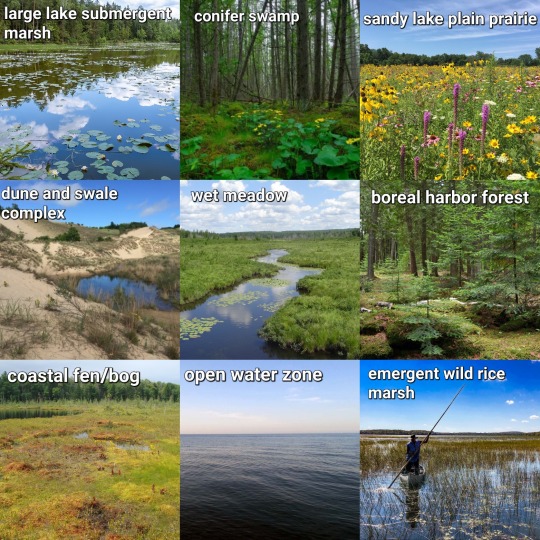
#poll#great lakes#ecosystems#ecology#marsh#lake#lakeposting#freshwater#wetlands#fen#bog#cattail#wild rice#forest#boreal#boreal forest#prairie#dune#dunes#dune and swale#estuary#delta#wet meadow#swamp
3K notes
·
View notes
Text
This is a really exciting development! We've already seen the positive effects of beavers returning to their historic range here in North America, so it's even better to see the same thing underway across the Atlantic. A single pair with their first litter of kits certainly isn't a large-scale reintroduction, but it's proof that these animals have the capacity to get back to work here.
Beavers are often called ecosystem engineers, and for good reason. These keystone species alter waterways by building dams and lodges, creating ponds and other aquatic habitats for species that can't handle faster-moving water. These also often serve as water reservoirs during summer droughts. The dams and lodges themselves may also provide nesting sites for birds and shelter for other animals, plants, and fungi.
Sadly there are still people who want to see beavers trapped and hunted as pests because their dams can sometimes flood fields, to include those that were historically seasonal wetlands. Until we stop seeing animals' value only in terms of whether they're useful to us or not, the beavers are going to face opposition as they reclaim their old territories on both continents.
Nonetheless, I give a hearty cheer to the Mammalian Corps of Engineers!
#beavers#beaver#mammals#rodent#wildlife#animals#ecosystems#ecology#restoration ecology#nature#environment#conservation#science#scicomm#hopepunk#endangered species#extinction#biodiversity#wild animals#good news
987 notes
·
View notes
Photo
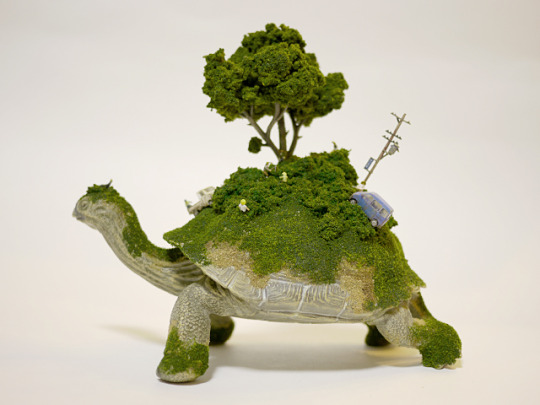

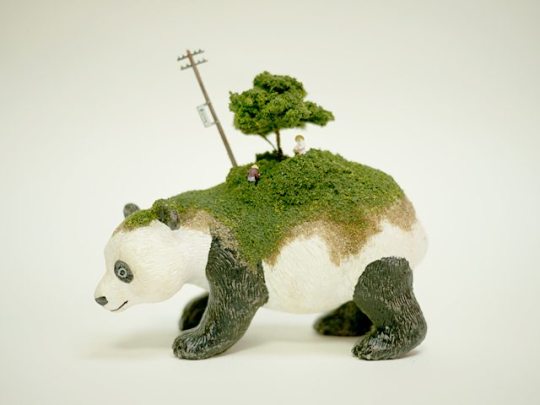


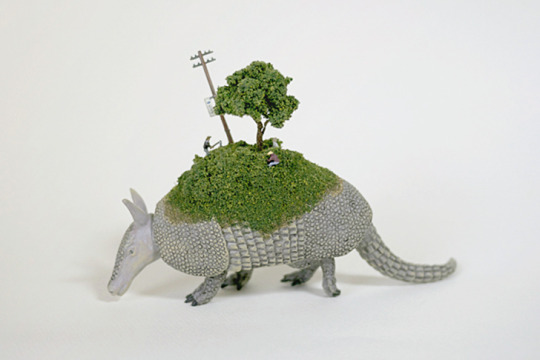


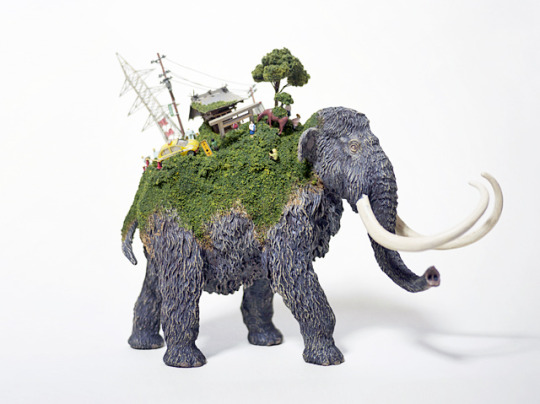
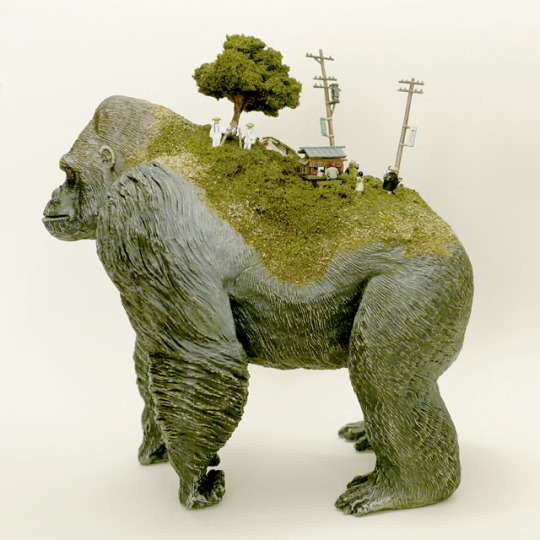
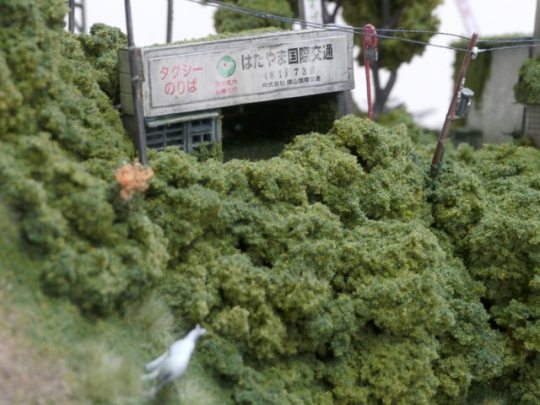



Maico Akiba (Japanese)
Sekai (World) - found objects
1K notes
·
View notes
Link
“There’s a huge untapped potential to consider conserving animals as a climate solution. If you do some of the rough calculations, the numbers rival those of what the IPCC is right now promoting in terms of converting everything to solar or wind generation...the numbers are in the same ballpark”
This is called called “trophic rewilding”--many animal species naturally cycle carbon into the soil just by living their lives and restoring these species to their natural range can turn their ecosystems back into carbon sinks.
“Fortunately, we have the technology to scrub CO2 from the atmosphere. It’s called nature.”
Looking at the list of environmental issues--pollution, climate change, species extinction, etc.--can feel overwhelming, but the reality is that nearly all of these issues are intimately connected. This is just one of many examples of how working on one issue also helps solve the others; if you conserve wildlife and restore habitat it also helps mitigate climate change.
(quotes from Oswald Schmitz)
#rewilding#wildlife#trophic rewilding#climate change#global warming#environment#hope#good news#animals#conservation#biodiversity#ecosystems#habitat#habitat restoration#hopepunk#postivity#ecoanxiety#climate anxiety#environmental despair#environmental grief
888 notes
·
View notes
Text
OK, so this is apparently a thing that is not known, so:
In a controlled, intentional, prescribed burn, the goal is NOT to burn down an entire forest, and every tree in it.
- it can be done to maintain grass lands by not allowing trees to get established
- it can be done to maintain an oak-savanna ecosystem, where it does clear out very young, non-fire adapted trees, but leaves the mature oaks.
- it can be done in a ponderosa pine forest, clearing out in invasive species but leaving the pines
- it can be done over a camas field, leaving the camas and other fire-adapted species, but burning invasive or aggressive species that would otherwise out compete them.
- I've read it can be used to maintain the Native Americans' berry patches, but I haven't read into that yet
- it can be used as part of a strategy to reduce the fuel for mega fires.
Prescribed burns are about maintaining ecosystem health and diversity, not about destroying them. Banning prescribed burns was part of what colonialists did, because they assumed they knew better than the native peoples. It has caused a lot of problems, including habitat loss.
Please read further, and don't dismiss it out of hand. A whole lot of us were raised on the idea that fire is always bad, but it's not. Here's one place to start reading:
287 notes
·
View notes
Text
Animal rights vs animal welfare , aka why I struggle to identify as vegan
Not every animal rights issue puts the welfare of the animals first, which is seen most often in groups such as peta.
In animal welfare cases there is such a large difference between different types of animals and peoples opinions on how they should be treated, it makes me wish there were universal rules that could be applied to all animals and people could get in serious trouble for it (its not illegal to keep a dog locked indoors without walking it but that doesn't mean it's good for the dog)
Personally and in my own experience, zoos and aquariums that have high welfare standards do help people to connect with and understand wild species better and it gives people more incentive to help that animal if they are endangered and aren't typically cute, I've seen it and experienced it with vultures, no one really cares about the conservation of vultures until they see them in person.
I fully believe that it's possible to ride horses with the horses permission and for the horse to enjoy it, as long as it is done correctly. Every horse breed we have today is a domesticated or comes from the domesticated species, there is only one true wild horse species left in the world - the przewalski's horse, with only one record of a person being able to ride one. Your shetlands/clydesdales/warmbloods/icelandics were bred to be domestic, they bred to carry people and pull carts. Is there a significant amount of abuse in the equine industry ? Yes. Is the current equestrian standard putting the horses needs first ? No. Is the "normal" / industry standard way of backing a horse beneficial for them ? Nope. But that doesn't mean none of it is, yes riding two year old horses can cause significant health problems but not everyone starts their horses at that age, it's becoming more common for individuals to start training their horse for ridden work at 4 years old because they are more developed physically and mentally. They can learn more complex things and develop more confidence. Yes, some people try to speed up the training process with abusive and harsh methods, but not everyone does.
Not every human-animal interaction is good or bad, it depends heavily on the circumstances of the situation and how the interaction is handled
Everyone is capable of harming animals when they aren't informed of their care/behavioural cues. I see far too many "animal sanctuaries" interacting and caring for animals in neglectful/dangerous/sometimes abusive methods because they haven't researched the animal they're trying to look after
I dont believe it's possible for all pets to be fed a plant based diet, and I don't believe that all exotic pets are inherently bad. Like I said before research is needed so you can look after them properly and obtain them through responsible methods.
Some culls are necessary to sustain the current ecosystem in place in certain areas, because humans messed up and removed natural predators or let invasive species take over (yes I'm talking about deer and grey squirrels, yes I will die on this hill, no you can't change my mind on this one)
#vegan#ecology#ecosystems#animal welfare#animal rights#veganism#animal rights activism#animal wellbeing#animal welfare activism#animal welfare act
559 notes
·
View notes
Text
okay. so.
i'm reading this book The Origins of the Modern World by Robert Marks
and even from the beginning i was getting this weird feeling from it. I'm always really wary of books that are broad overviews of history that claim to explore big theory-of-everything explanations for very broad phenomena, because history is unbelievably complex and there is so much disagreement between historians about everything.
But anyway I come to this section (in the first chapter)
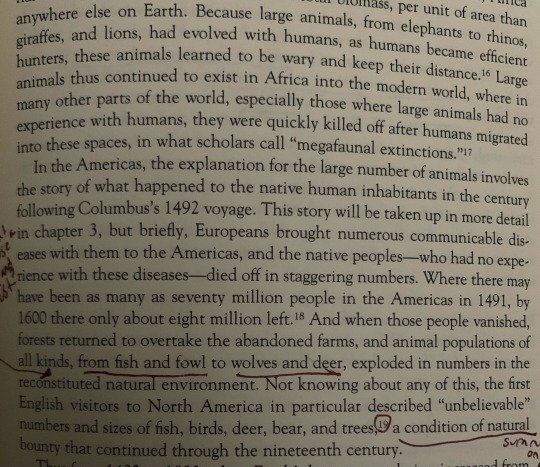
This writer's opinion is that the Americas seemed so abundant when English settlers first arrived because the Native Americans had been mostly killed, and as a result, the wildlife increased greatly in numbers and forests overtook the farms, creating what appeared to be a natural paradise.
I'm immediately suspicious of this paragraph because arguing that the mass death of Native Americans was good for nature seems really contradictory to the research I've explored, on top of being just...disgusting.
But it doesn't sound right in regards to how ecosystems work either. If populations of animals had recently exploded after millennia of being limited by a major predator, it would cause the plants to be overwhelmed by the herbivore populations. The land would be stripped barren and eroded, and soon the animals would be weak and starving.
So I thought to myself, huh, a citation. I will look at the citation and see what it says.
It's a book called Changes in the Land by William Cronon, who seems to be one of the most important and respected guys in his field. I thought, I have to find this book. So I did, I found the book, and spent like an hour reading through it.
And what I discovered, is that Cronon's book directly contradicts what Marks says in the paragraph that cites Cronon?!

So basically this entire book, Changes in the Land, is a detailed exploration of how the arrival of English settlers, the decline of Native American populations, and the slow transition to European farming and land use practices caused increasing degradation to the ecosystem, beginning very early on in colonization.
Changes in the Land quotes a great array of documents from the colonial period where settlers observed the soil becoming depleted, animals disappearing, and the climate itself becoming more hostile even in the 1600's. It's actually a really fascinating book.
Cronon tells us that Native Americans created lush and abundant conditions for wild animals by causing a "mosaic" of habitats, with different areas representing various stages of ecological succession. With this great diversity in habitats, and lots of transitional "edges" between them, the prosperity of the animal life was maximized. This was intentional, and really a type of farming.
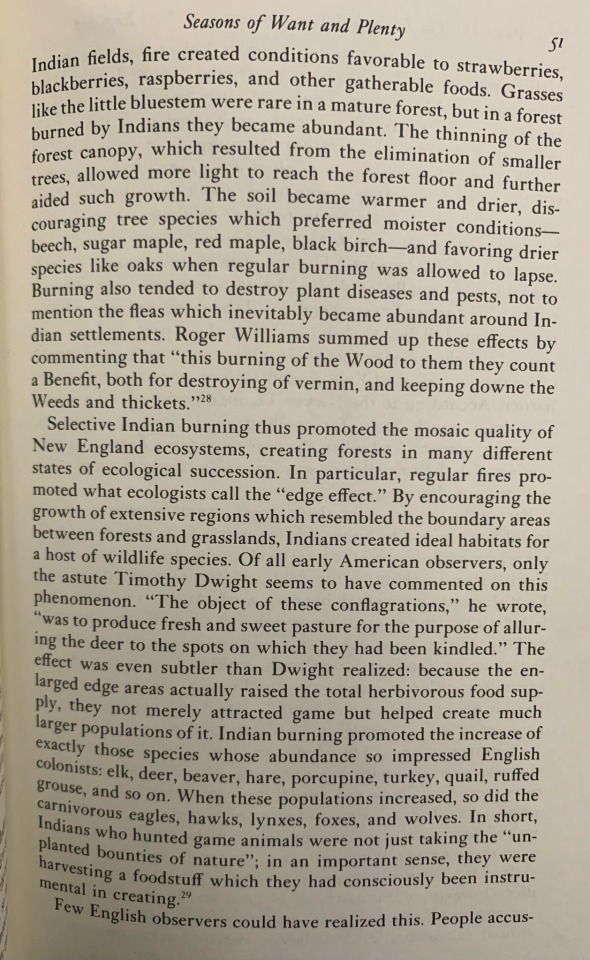
The book essentially explains how European settlers couldn't recognize Native American life ways as "agriculture," they thought the land was just supernaturally abundant all by itself because of its inherent nature, and yet almost immediately after settlers came, the abundance of the land degraded and vanished. The settlers cut down vast amounts of trees, which caused erosion, which destroyed the river and stream ecosystems and starved the soil of nutrients. Destruction of forest caused less rain, and more extreme temperatures. It became a vicious cycle where the settlers had to abuse the land more and more just to survive.
The spiral pulled in Native American communities too, forcing them to turn to more exploitative means of survival like the fur trade, (which depleted the beaver population, which caused the decline of beaver ponds, which harmed the whole forest). It describes how the changing ecosystems left Native Americans with no choice but to turn to European practices for survival, which in turn depleted the land even further.
Even I was surprised to learn just how early on environmental disaster set in, and the incredible extent of it. English farming practices literally reshaped the map of New Haven between the 17th and 18th centuries:
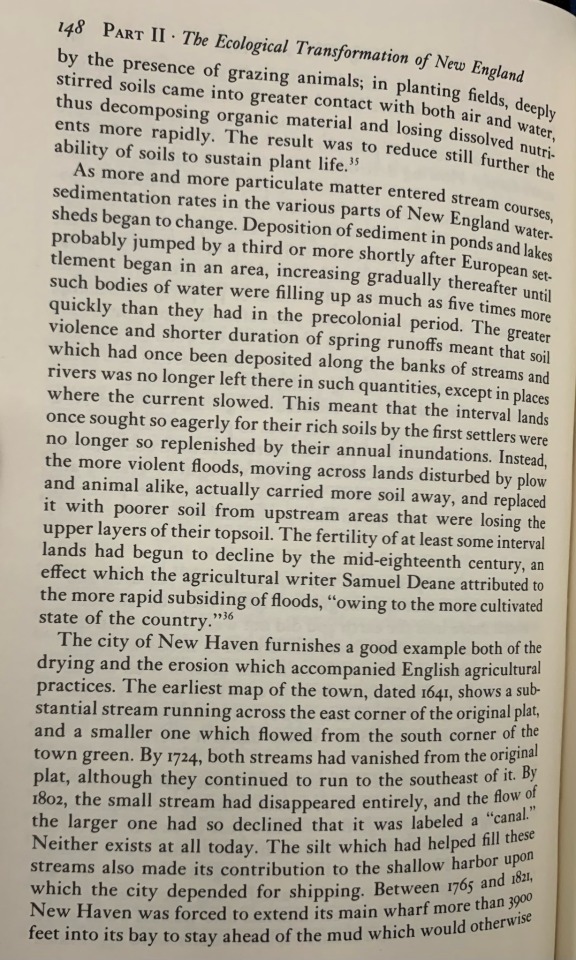
To return to Marks, though...Marks' statement in the excerpt, where he says the "abundance" of animals continued throughout the 19th century, is blatantly false according to the source HE CITES.
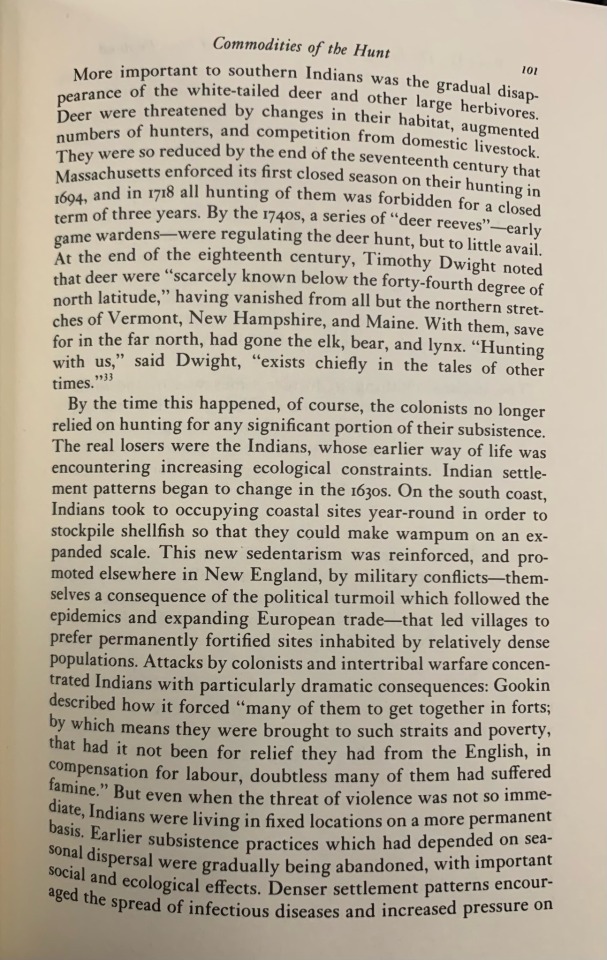
Deer were becoming scarce in New England by the 1690's. It was so bad by 1718 that deer hunting was forbidden for 3 years at that time, and by 1800, deer were almost extirpated from New England. The book explains on another page that wild turkeys became so rare that a farmer's manual from the time said their domesticated turkeys were from Turkey—settlers had no opportunity to see a wild turkey and no idea they existed.
Marks is supporting his statement using a source entirely dedicated to contradicting the exact thing he's saying! It's unbelievable.
How does this happen? Did Marks just have his own opinion and insert a famous book that seemed to be on the subject as support, without reading it?
I'm thinking now of all the times I've read a book and seen a citation on a statement and unconsciously thought "oh, well it seems there is evidence, so it must be reliable" when actually, something like this was happening. The array of ways misinformation can be propagated and never be found out is terrifying.
2K notes
·
View notes
Text
"Marginal improvements to agricultural soils around the world would store enough carbon to keep the world within 1.5C of global heating, new research suggests.
Farming techniques that improve long-term fertility and yields can also help to store more carbon in soils but are often ignored in favor of intensive techniques using large amounts of artificial fertilizer, much of it wasted, that can increase greenhouse gas emissions.
Using better farming techniques to store 1 percent more carbon in about half of the world’s agricultural soils would be enough to absorb about 31 gigatons of carbon dioxide a year, according to new data. That amount is not far off the 32 gigaton gap between current planned emissions reduction globally per year and the amount of carbon that must be cut by 2030 to stay within 1.5C.
The estimates were carried out by Jacqueline McGlade, the former chief scientist at the UN environment program and former executive director of the European Environment Agency. She found that storing more carbon in the top 30 centimeters of agricultural soils would be feasible in many regions where soils are currently degraded.
McGlade now leads a commercial organization that sells soil data to farmers. Downforce Technologies uses publicly available global data, satellite images, and lidar to assess in detail how much carbon is stored in soils, which can now be done down to the level of individual fields.
“Outside the farming sector, people do not understand how important soils are to the climate,” said McGlade. “Changing farming could make soils carbon negative, making them absorb carbon, and reducing the cost of farming.”
She said farmers could face a short-term cost while they changed their methods, away from the overuse of artificial fertilizer, but after a transition period of two to three years their yields would improve and their soils would be much healthier...
Arable farmers could sequester more carbon within their soils by changing their crop rotation, planting cover crops such as clover, or using direct drilling, which allows crops to be planted without the need for ploughing. Livestock farmers could improve their soils by growing more native grasses.
Hedgerows also help to sequester carbon in the soil, because they have large underground networks of mycorrhizal fungi and microbes that can extend meters into the field. Farmers have spent decades removing hedgerows to make intensive farming easier, but restoring them, and maintaining existing hedgerows, would improve biodiversity, reduce the erosion of topsoil, and help to stop harmful agricultural runoff, which is a key polluter of rivers."
-via The Grist, July 8, 2023
#agriculture#sustainable agriculture#sustainability#carbon emissions#carbon sequestration#livestock#farming#regenerative farming#native plants#ecosystems#global warming#climate change#good news#hope
4K notes
·
View notes
Text
Happy International Day of Forests!
May every forest flourish in its unique diversity, providing diverse ecosystems and homes for all wildlife , oxygen for everyone, and sustain all life on earth - and may people, all humans wake up to their inherent worth and value, and protect them - and all native trees everywhere - from being cleared in the arrogance of anthropocentrism.
#Forests#International Day of Forests#Earth#21st March 2024#International Day of Forests 2024#International Day of Forests 21st March 2024#Nature#Trees#Ecosystems#Wildlife#Keep your native trees#Plants#Keep your native plants#Native plants#Native trees
36 notes
·
View notes
Text
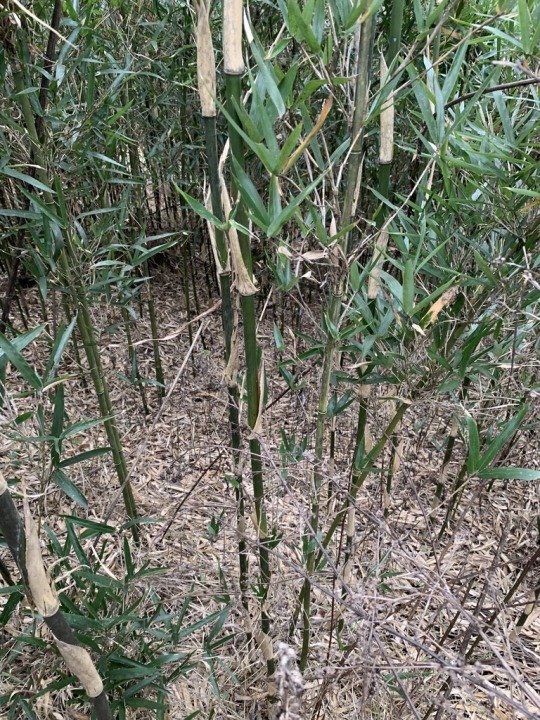



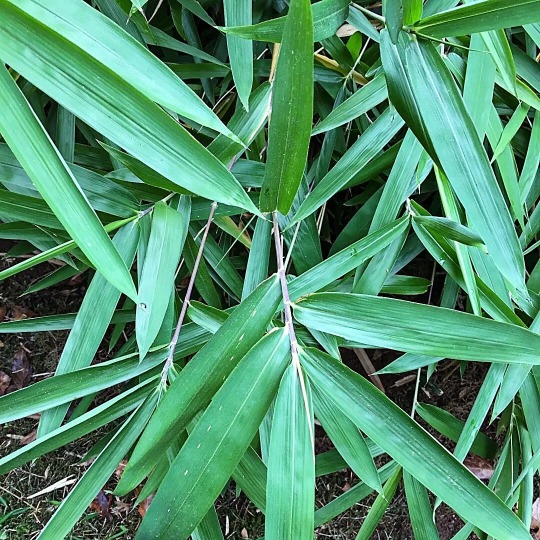
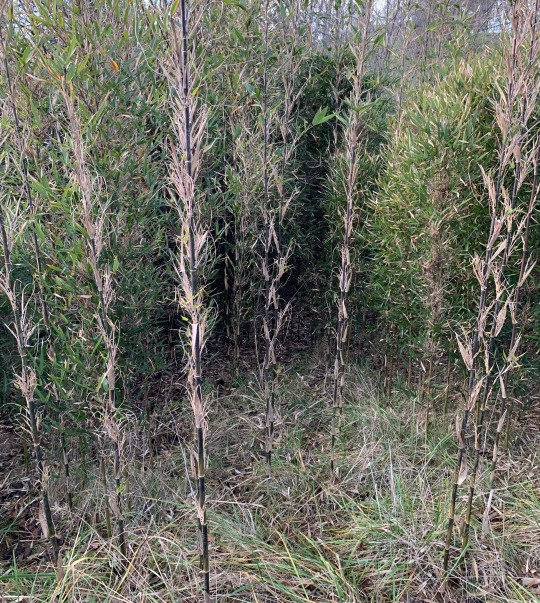
Cool Plant: Arundinaria gigantea
Giant River Cane
This plant is extra special! Not only is it one of three members of the genus Arundinaria, which together are North America's only native bamboo, it also once formed extensive bamboo forests in the American Southeast known as canebrakes, where the bamboo stalks could exceed 30 feet tall! The bamboo forests are thought to have covered 10 million acres of the southeastern United States.
River cane grows in damp areas such as low-lying woods and the edges of creeks, and has incredible abilities for resisting erosion and filtering contaminants from groundwater. It is a fire dependent species, and canebrakes were maintained by Native Americans using controlled burns. Native American peoples such as the Cherokee and the Choctaw used the river cane as a super tough all purpose crafting material for everything from flutes and blowguns to baskets, backpacks, mats and bed frames.
Nowadays, it mostly only exists in small patches along fences and in ditches, where it usually grows no taller than 10 feet or so. Since it grows in large clonal colonies and only produces seeds once before the entire patch dies, it is hard for it to reproduce these days. The destruction of the canebrakes by colonists' cattle, plowing, and neglect of the caretaking practices are thought to have helped drive the Carolina parakeet and passenger pigeon to extinction.
Many other species depend on the Arundinaria bamboos to live: there are at least 9 butterfly and moth species that use it as a host plant, and some of the rarest plants in the Southeast, including the Venus flytrap, are often found in remaining fragments of canebrakes.
202 notes
·
View notes
Text
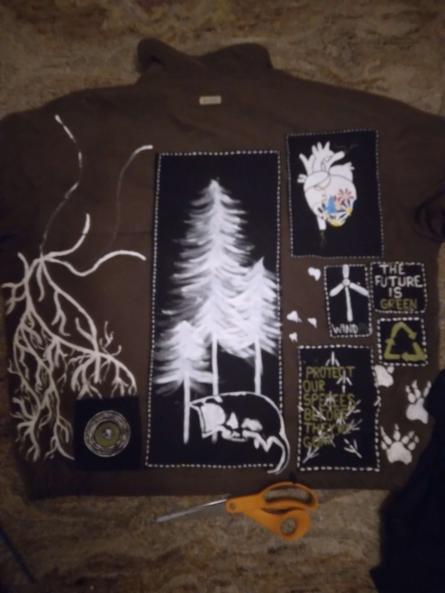
jacket in the works
57 notes
·
View notes
Text
Why Forests Need Salmon
(Originally posted at my blog at https://rebeccalexa.com/why-forests-need-salmon/)
One of my favorite fall activities is to check local streams for salmon runs. Here in the Pacific Northwest, and extending north into Alaska, we have seven species of anadromous Salmonidae: chinook salmon (Oncorhynchus tshawytscha), chum salmon (Oncorhynchus keta), coho salmon (Oncorhynchus kisutch), sockeye salmon (Oncorhynchus nerka), pink salmon (Oncorhynchus gorbuscha), coastal cutthroat trout (Oncorhynchus clarkii clarkii), and steelhead (Oncorhynchus mykiss). My favorite run is the chum salmon that run up Ellsworth Creek in southwest Washington each fall, but I’m honestly just happy to see any migrating salmon. And as I hike through stands of ancient western red cedar (Thuja plicata), I like to think about the many ways in which these and other forests need salmon for their ongoing health.
Anadromous fish are those that are born in fresh water, spend much of their adult lives in salt water, and then return to fresh water to spawn. Some, like Atlantic salmon (Salmo salar) and some populations of American shad (Alosa sapidissima) are iteroparous, meaning they can make this journey multiple times in a lifetime. Pacific salmonids, on the other hand, are semelparous, meaning that they spawn once and then die shortly thereafter. (From here on out I am going to use “salmon” as a general, casual term referring to both the Oncorhynchus species, and the steelhead and cutthroat trout.)
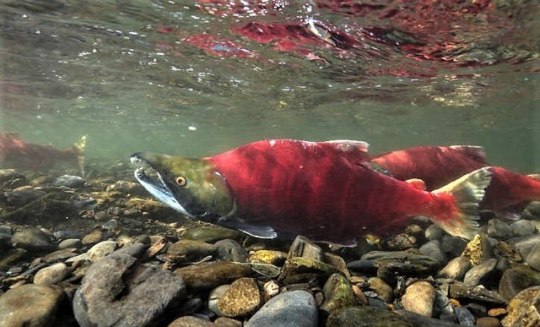
Pacific salmon were originally freshwater fish that inhabited lakes and slow-moving rivers. Somewhere around 25 million years ago, the climate cooled significantly, with average temperatures dropping almost twenty degrees F. We’re not sure at what point after this the salmon began expanding into brackish estuaries and then the Pacific Ocean itself, but when they did they found rich sources of food unlike what they had access to in fresh water. Over time, they evolved a life cycle that let them be born in the relatively safe shelter of freshwater streams, and then go out to the ocean to feast on the banquet found there when they were large enough to have a better chance of survival.
Eventually salmon runs could be found in streams as far inland as eastern Idaho, eastern British Columbia, and the southern two-thirds of Alaska (with some Alaskan runs even crossing over into Canada!) And until the arrival of European colonizers, these streams consistently provided indigenous people all along the Pacific coastline an incredibly important source of food, cultural and economic trade, mythos, and more. Unfortunately, the newcomers overharvested the salmon, dammed and destroyed streams and other habitat, and of course spearheaded the causes of anthropogenic climate change.

Indigenous people fish for salmon at Celilo Falls on the Columbia River. As the single longest continuously inhabited community in North America (over 15,000 years!), this location was a home and hub of cultural activity for many indigenous tribes and communities across the region before it was flooded by the completion of the Dalles Dam in 1957.
All these factors have led to a precipitous decline in the size of both salmon runs, and the salmon themselves. This isn’t just detrimental to indigenous communities, though. It also threatens the health of forests all throughout the salmons’ range.
A forest isn’t just made of trees. It’s composed of entire plant communities, fungi (including mycorrhizal species), and the animals, bacteria, and other living beings that share space with them. When salmon travel up and down the waterways as fry, and then later to spawn as adults, they have a direct impact on that ecosystem.
Salmon fry are an important source of food for larger fish, amphibians, birds, and other beings that seek food in the water. In fact, part of why salmon lay so many eggs (over 5,000 in the case of chinook!) is because most of the fry that hatch will never make it to adulthood. But adult salmon aren’t safe from predation on their return trip to their birthplaces. In fact, they are caught and eaten by a wide variety of animals from bears to eagles, wolves to osprey, sea lions to bobcats.
Bears are of particular interest here. Brown bears (Ursus arctos) are well-known for gorging on summer and fall salmon runs to build up massive amounts of fat in preparation for winter hibernation. (Katmai National Park even celebrates their bears during Fat Bear Week every October!) You can watch video feeds of several bears hanging out in their favorite fishing spots by waterfalls and in the flow of the river.
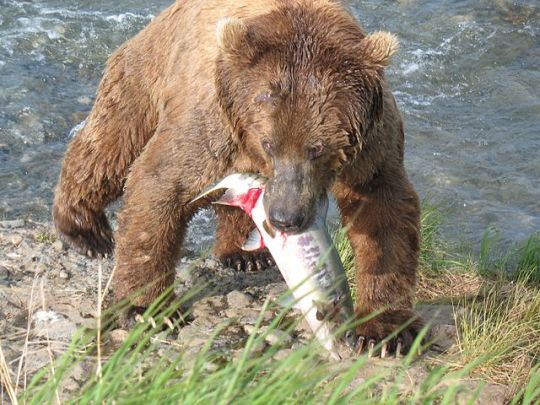
Imagine that you are a young bear, perhaps recently forced to independence by your mother who is now focused on your younger siblings. You have to not only start catching fish without her protection from bigger bears, but you also need to make sure those stronger bears don’t steal your catch. What’s the best thing to do? Run far away into the woods to eat your salmon in peace, then leave the remains among the trees and head back for more.
If the fishing is good, bears will often eat only the fattiest parts of the salmon like the brains and skin, and then leave the rest behind for scavengers. The nutrients in the salmon then disseminate throughout the forest, whether carried in the digestive systems of animals, or broken down in place by decomposers. This helps make the nutrients available to the plants, particularly trees which may store massive amounts of nutrients in their trunks; when the trees die, they essentially become a food pantry for younger beings like new seedlings, fungi, and so forth.
Now–what’s so special about the nutrients in salmon? Well, remember that these fish spend years out in the ocean. And the ocean has an entirely different balance of nutrients floating around in it compared to what’s found in fresh water or on land. The salmon are essentially the only way these ocean-borne nutrients can make their way into the forest in any meaningful amount, and they do so on a regular basis each year. The trees near salmon runs fished by bears may be 300% larger than usual, and salmon also provide nearly three quarters of the nitrogen in the forest. That’s a pretty impressive contribution!

This isn’t just about how forests need salmon; it’s a reciprocal relationship. While the salmon’s immediate habitats are aquatic, these streams, rivers, and other waterways are directly affected by what happens on the land around them.
Every waterway has a watershed–an area of land from which precipitation drains into that waterway. These watersheds nest within each other; the watersheds of small streams are nested within the watersheds of the rivers the streams feed into. That water carries things with it, from soil to pollutants. So the health of the land has a direct impact on what is found in the water.
But it goes beyond what’s washed downstream, and into how it’s washed down. In a healthy forest, for example, the soil is able to absorb a significant amount of precipitation that falls throughout the year, keeping it from simply cascading down hillsides to create flooding and landslides. Water is also stored in the various living beings in the forest; again trees are often the champions with their great size, but smaller plants help with water retention quite a bit as well, both through internal storage and preventing evaporation from soil. A forest that is badly damaged, such as through a clearcut or wildfire, won’t hold water as well. This can lead to floods, landslides and other erosion, and increase the impact of summer droughts as the land simply can’t store as much water, or for as long.
All of this affects the salmon directly. If the watershed is no longer holding and releasing snowmelt, rain, and other water in a controlled manner, this can lead to flooding in waterways which can wash away salmon eggs and fry. Increased erosion buries the gravel that salmon lay eggs in with silt, smothering the eggs so they never hatch. When a riparian zone–the land along a waterway–is stripped of vegetation, the water loses crucial shaded areas that keep temperatures cool. Salmon easily overheat when temperatures rise even a few degrees. And drought can dry up smaller streams, stranding and even killing young salmon while preventing adults from reaching their spawning grounds.
While not every single salmon run exclusively travels through forests, many of them do. And many spawning grounds are found in forests, or at least areas with significant tree cover in riparian zones. Salmon must have healthy forests in order to continue to survive, and the loss of these forests is just one of many factors contributing to their severe decline.
Thankfully, I am far from the only person concerned about the safety of our wild Pacific salmon. There are numerous organizations working to protect and restore salmon habitat through dam removal, preservation and restoration of aquatic habitat and surrounding land, regulations on salmon fishing, and educating people about sustainable seafood options (or just not eating seafood at all.) And even habitat restoration efforts that aren’t directly in salmon-inhabited waterways still have a positive impact on the forest ecosystem as a whole.
We know that forests need salmon, and salmon need forests. To protect one is to protect the other, and long may they both thrive.
Did you enjoy this post? Consider taking one of my online foraging and natural history classes, checking out my other articles, or picking up a paperback or ebook I’ve written! You can even buy me a coffee here!
#long post#salmon#fish#forests#nature#ecology#science#science communication#scicomm#wildlife#bears#Pacific Northwest#PNW#ecosystems#biology#extinction#endangered species#conservation#environment#environmentalism
608 notes
·
View notes